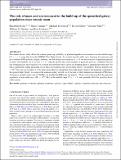Files in this item
The role of mass and environment in the build-up of the quenched galaxy population since cosmic noon
Item metadata
| dc.contributor.author | Taylor, Elizabeth | |
| dc.contributor.author | Almaini, Omar | |
| dc.contributor.author | Merrifield, Michael | |
| dc.contributor.author | Maltby, David | |
| dc.contributor.author | Wild, Vivienne | |
| dc.contributor.author | Hartley, William G | |
| dc.contributor.author | Rowlands, Kate | |
| dc.date.accessioned | 2023-05-04T16:30:07Z | |
| dc.date.available | 2023-05-04T16:30:07Z | |
| dc.date.issued | 2023-06-01 | |
| dc.identifier | 285339901 | |
| dc.identifier | f87337f3-0ba1-4bde-b23a-eebd44ac3461 | |
| dc.identifier | 85161244679 | |
| dc.identifier.citation | Taylor , E , Almaini , O , Merrifield , M , Maltby , D , Wild , V , Hartley , W G & Rowlands , K 2023 , ' The role of mass and environment in the build-up of the quenched galaxy population since cosmic noon ' , Monthly Notices of the Royal Astronomical Society , vol. 522 , no. 2 , pp. 2297-2306 . https://doi.org/10.1093/mnras/stad1098 | en |
| dc.identifier.issn | 0035-8711 | |
| dc.identifier.other | Bibtex: 10.1093/mnras/stad1098 | |
| dc.identifier.uri | https://hdl.handle.net/10023/27515 | |
| dc.description | Funding: VW acknowledges Science and Technology Facilities Council grant ST/V000861/1. | en |
| dc.description.abstract | We conduct the first study of how the relative quenching probability of galaxies depends on environment over the redshift range 0.5 < z <3, using data from the UKIDSS Ultra Deep Survey. By constructing the stellar mass functions for quiescent and post-starburst (PSB) galaxies in high-, medium-, and low-density environments to z = 3, we find an excess of quenched galaxies in dense environments out to at least z ∼ 2. Using the growth rate in the number of quenched galaxies, combined with the star-forming galaxy mass function, we calculate the probability that a given star-forming galaxy is quenched per unit time. We find a significantly higher quenching rate in dense environments (at a given stellar mass) at all redshifts. Massive galaxies (M* > 1010.7 M⊙) are on average 1.7 ± 0.2 times more likely to quench per Gyr in the densest third of environments compared to the sparsest third. Finally, we compare the quiescent galaxy growth rate to the rate at which galaxies pass through a PSB phase. Assuming a visibility time-scale of 500 Myr, we find that the PSB route can explain ∼50 per cent of the growth in the quiescent population at high stellar mass (M* > 1010.7 M⊙) in the redshift range 0.5 < z < 3, and potentially all of the growth at lower stellar masses. | |
| dc.format.extent | 10 | |
| dc.format.extent | 1344226 | |
| dc.language.iso | eng | |
| dc.relation.ispartof | Monthly Notices of the Royal Astronomical Society | en |
| dc.subject | Galaxies: evolution | en |
| dc.subject | Galaxies: formation | en |
| dc.subject | Galaxies: high-redshift | en |
| dc.subject | Galaxies: luminosity function | en |
| dc.subject | Mass function | en |
| dc.subject | QB Astronomy | en |
| dc.subject | QC Physics | en |
| dc.subject | 3rd-DAS | en |
| dc.subject | MCC | en |
| dc.subject.lcc | QB | en |
| dc.subject.lcc | QC | en |
| dc.title | The role of mass and environment in the build-up of the quenched galaxy population since cosmic noon | en |
| dc.type | Journal article | en |
| dc.contributor.sponsor | Science & Technology Facilities Council | en |
| dc.contributor.institution | University of St Andrews. School of Physics and Astronomy | en |
| dc.identifier.doi | 10.1093/mnras/stad1098 | |
| dc.description.status | Peer reviewed | en |
| dc.identifier.grantnumber | ST/V000861/1 | en |
This item appears in the following Collection(s)
Items in the St Andrews Research Repository are protected by copyright, with all rights reserved, unless otherwise indicated.

